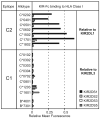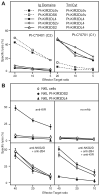Humans differ from other hominids in lacking an activating NK cell receptor that recognizes the C1 epitope of MHC class I
- PMID: 20802150
- PMCID: PMC3124310
- DOI: 10.4049/jimmunol.1001951
Humans differ from other hominids in lacking an activating NK cell receptor that recognizes the C1 epitope of MHC class I
Abstract
Modulation of human NK cell function by killer cell Ig-like receptors (KIR) and MHC class I is dominated by the bipartite interactions of inhibitory lineage III KIR with the C1 and C2 epitopes of HLA-C. In comparison, the ligand specificities and functional contributions of the activating lineage III KIR remain poorly understood. Using a robust, sensitive assay of KIR binding and a representative panel of 95 HLA class I targets, we show that KIR2DS1 binds C2 with ~50% the avidity of KIR2DL1, whereas KIR2DS2, KIR2DS3, and KIR2DS5 have no detectable avidity for C1, C2, or any other HLA class I epitope. In contrast, the chimpanzee has activating C1- and C2-specific lineage III KIR with strong avidity, comparable to those of their paired inhibitory receptors. One variant of chimpanzee Pt-KIR3DS2, the activating C2-specific receptor, has the same avidity for C2 as does inhibitory Pt-KIR3DL4, and a second variant has ~73% the avidity. Chimpanzee Pt-KIR3DS6, the activating C1-specific receptor, has avidity for C1 that is ~70% that of inhibitory Pt-KIR2DL6. In both humans and chimpanzees we observe an evolutionary trend toward reducing the avidity of the activating C1- and C2-specific receptors through selective acquisition of attenuating substitutions. However, the extent of attenuation has been extreme in humans, as exemplified by KIR2DS2, an activating C1-specific receptor that has lost all detectable avidity for HLA class I. Supporting such elimination of activating C1-specific receptors as a uniquely human phenomenon is the presence of a high-avidity activating C1-specific receptor (Gg-KIR2DSa) in gorilla.
Figures




Similar articles
-
Chimpanzees use more varied receptors and ligands than humans for inhibitory killer cell Ig-like receptor recognition of the MHC-C1 and MHC-C2 epitopes.J Immunol. 2009 Mar 15;182(6):3628-37. doi: 10.4049/jimmunol.0803401. J Immunol. 2009. PMID: 19265141 Free PMC article.
-
KIR2DS5 allotypes that recognize the C2 epitope of HLA-C are common among Africans and absent from Europeans.Immun Inflamm Dis. 2017 Dec;5(4):461-468. doi: 10.1002/iid3.178. Epub 2017 Jul 6. Immun Inflamm Dis. 2017. PMID: 28685972 Free PMC article.
-
Polymorphic HLA-C Receptors Balance the Functional Characteristics of KIR Haplotypes.J Immunol. 2015 Oct 1;195(7):3160-70. doi: 10.4049/jimmunol.1501358. Epub 2015 Aug 26. J Immunol. 2015. PMID: 26311903 Free PMC article.
-
Two to Tango: Co-evolution of Hominid Natural Killer Cell Receptors and MHC.Front Immunol. 2019 Feb 19;10:177. doi: 10.3389/fimmu.2019.00177. eCollection 2019. Front Immunol. 2019. PMID: 30837985 Free PMC article. Review.
-
KIR specificity and avidity of standard and unusual C1, C2, Bw4, Bw6 and A3/11 amino acid motifs at entire HLA:KIR interface between NK and target cells, the functional and evolutionary classification of HLA class I molecules.Int J Immunogenet. 2019 Aug;46(4):217-231. doi: 10.1111/iji.12433. Epub 2019 Jun 18. Int J Immunogenet. 2019. PMID: 31210416 Review.
Cited by
-
Can Selective MHC Downregulation Explain the Specificity and Genetic Diversity of NK Cell Receptors?Front Immunol. 2015 Jun 16;6:311. doi: 10.3389/fimmu.2015.00311. eCollection 2015. Front Immunol. 2015. PMID: 26136746 Free PMC article.
-
Following Transplantation for Acute Myelogenous Leukemia, Donor KIR Cen B02 Better Protects against Relapse than KIR Cen B01.J Immunol. 2021 Jun 15;206(12):3064-3072. doi: 10.4049/jimmunol.2100119. Epub 2021 Jun 11. J Immunol. 2021. PMID: 34117109 Free PMC article.
-
Innate immune genes synergize to predict increased risk of chronic disease in hepatitis C virus infection.Proc Natl Acad Sci U S A. 2011 Apr 5;108(14):5736-41. doi: 10.1073/pnas.1016358108. Epub 2011 Mar 14. Proc Natl Acad Sci U S A. 2011. PMID: 21402922 Free PMC article.
-
Activating KIR and HLA Bw4 ligands are associated to decreased susceptibility to pemphigus foliaceus, an autoimmune blistering skin disease.PLoS One. 2012;7(7):e39991. doi: 10.1371/journal.pone.0039991. Epub 2012 Jul 2. PLoS One. 2012. PMID: 22768326 Free PMC article. Clinical Trial.
-
KIR/HLA interactions and pathogen immunity.J Biomed Biotechnol. 2011;2011:298348. doi: 10.1155/2011/298348. Epub 2011 May 19. J Biomed Biotechnol. 2011. PMID: 21629750 Free PMC article. Review.
References
-
- Moretta A, Bottino C, Vitale M, Pende D, Biassoni R, Mingari MC, Moretta L. Receptors for HLA class-I molecules in human natural killer cells. Annu Rev Immunol. 1996;14:619–648. - PubMed
-
- Carlyle JR, Mesci A, Fine JH, Chen P, Belanger S, Tai LH, Makrigiannis AP. Evolution of the Ly49 and Nkrp1 recognition systems. Semin Immunol. 2008;20:321–330. - PubMed
-
- Natarajan K, Dimasi N, Wang J, Mariuzza RA, Margulies DH. Structure and function of natural killer cell receptors: multiple molecular solutions to self, nonself discrimination. Annu Rev Immunol. 2002;20:853–885. - PubMed
-
- Biassoni R, Pessino A, Malaspina A, Cantoni C, Bottino C, Sivori S, Moretta L, Moretta A. Role of amino acid position 70 in the binding affinity of p50.1 and p58.1 receptors for HLA-Cw4 molecules. Eur J Immunol. 1997;27:3095–3099. - PubMed
Publication types
MeSH terms
Substances
Grants and funding
LinkOut - more resources
Full Text Sources
Research Materials
Miscellaneous

